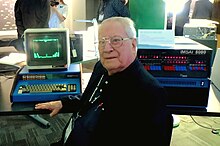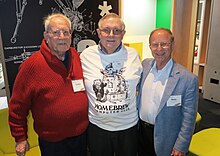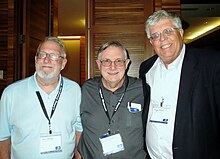Homebrew Computer Club
The club had an influential role in the development of the microcomputer revolution and the rise of that aspect of the Silicon Valley information technology industrial complex.
With its newsletter and monthly meetings promoting an open exchange of ideas, the club has been described as "the crucible for an entire industry" as it pertains to personal computing.
Others, at the suggestion of Roger Melen, convened at The Oasis,[8] a bar and grill they considered a pub located on El Camino Real in nearby Menlo Park, recalled years later by a member as "Homebrew's other staging area".
[9][self-published source] As Steven Levy wrote about the Oasis gatherings: Piling into wooden booths with tables deeply etched with the initials of generations of Stanford students, Garland and Melen and Marsh and Felsenstein and Dompier and French and whoever else felt like showing up would get emboldened by the meeting's energy and pitchers of beer.
[12] From the ranks of this club came the founders of many microcomputer companies, including Steve Wozniak and Steve Jobs (Apple Computer), Harry Garland and Roger Melen (Cromemco), Thomas "Todd" Fischer (IMSAI Division, Fischer-Freitas Company), George Morrow (Morrow Designs), Paul Terrell (Byte Shop), Adam Osborne (Osborne Computer), and Bob Marsh (Processor Technology).
[14][self-published source] Steve Inness was a primary designer of one of the early cell phone touch screens as well as a business partner with John Draper.
One such influential event was the publication of Bill Gates's "Open Letter to Hobbyists", which lambasted the early hackers of the time for violating the copyrights of commercial software programs.
[21] The second volume began on January 31, 1976, and included sections for A LETTER FROM MITS, CASSETTE UPDATE, TINY BASIC, MEETING FACILITIES, SOFTWARE, PROBLEMS, MEETING-1, and ALTAIR 680.





